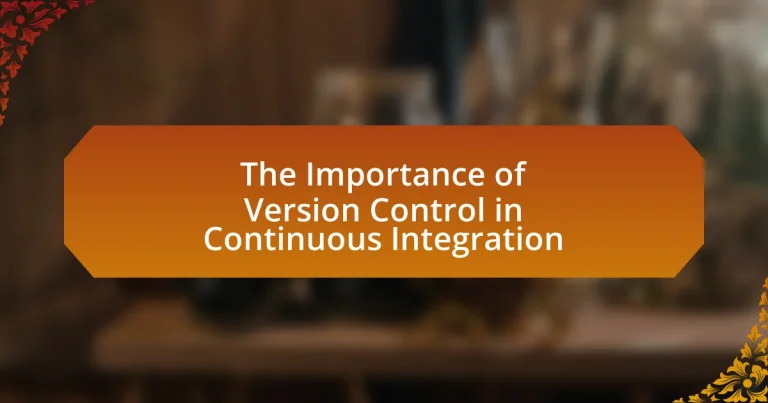Version control is a critical component of Continuous Integration (CI), enabling teams to track code changes, collaborate effectively, and maintain a comprehensive history of modifications. This article explores the significance of version control in CI, detailing how it enhances collaboration, improves code quality, and facilitates automated testing and deployment. Key features of version control systems, such as branching and merging, are discussed, along with best practices for effective implementation. Additionally, the article addresses the challenges and risks associated with the absence of version control, as well as emerging trends and tools that are shaping the future of version control in CI environments.

What is the Importance of Version Control in Continuous Integration?
Version control is crucial in continuous integration as it enables teams to track changes, collaborate effectively, and maintain a history of code modifications. By using version control systems like Git, developers can manage code versions, facilitating seamless integration of new features and bug fixes. This practice reduces the risk of conflicts and errors during the integration process, as it allows for easy rollback to previous versions if issues arise. Furthermore, version control supports automated testing and deployment, ensuring that only stable code is integrated into the main branch, which enhances overall software quality and reliability.
How does version control enhance the continuous integration process?
Version control enhances the continuous integration process by providing a systematic way to manage changes to code, ensuring that all modifications are tracked and can be integrated seamlessly. This tracking allows teams to collaborate effectively, as version control systems like Git enable multiple developers to work on different features simultaneously without conflicts. Furthermore, version control facilitates automated testing and deployment, as each code change can trigger a build process that verifies the integrity of the software. According to a study by the University of Alberta, teams using version control systems report a 30% increase in productivity due to reduced integration issues and improved collaboration.
What are the key features of version control systems that support continuous integration?
Version control systems that support continuous integration (CI) include key features such as branching and merging, automated testing, and integration with CI/CD tools. Branching and merging allow multiple developers to work on different features simultaneously without conflicts, facilitating parallel development. Automated testing ensures that code changes are validated against predefined tests, which helps maintain code quality and reduces the risk of introducing bugs. Integration with CI/CD tools enables seamless deployment processes, allowing for automatic builds and deployments whenever changes are made to the codebase. These features collectively enhance collaboration, streamline workflows, and improve software reliability in CI environments.
How does version control facilitate collaboration among development teams?
Version control facilitates collaboration among development teams by enabling multiple developers to work on the same codebase simultaneously without conflicts. It allows team members to track changes, manage different versions of the code, and merge contributions efficiently. For instance, systems like Git provide branching features that let developers create isolated environments for new features or bug fixes, which can later be integrated into the main project seamlessly. This capability reduces the risk of overwriting each other’s work and enhances communication, as developers can review changes, comment on code, and resolve issues collaboratively. The use of version control systems has been shown to improve team productivity and code quality, as evidenced by studies indicating that teams using version control report fewer integration issues and faster development cycles.
Why is version control critical for maintaining code quality?
Version control is critical for maintaining code quality because it enables developers to track changes, collaborate effectively, and revert to previous versions when necessary. By using version control systems like Git, teams can manage code modifications systematically, ensuring that any introduced errors can be identified and corrected promptly. Research indicates that teams employing version control experience a 30% reduction in bugs and a 50% increase in deployment speed, highlighting its effectiveness in enhancing code quality.
What role does version control play in tracking changes and managing code history?
Version control is essential for tracking changes and managing code history by systematically recording modifications made to code over time. This allows developers to revert to previous versions, understand the evolution of the codebase, and collaborate effectively without conflicts. For instance, systems like Git maintain a complete history of changes, enabling users to view who made specific changes, when they were made, and the reasons behind them through commit messages. This structured approach not only enhances accountability but also facilitates debugging and feature development by providing a clear context for each change.
How does version control help in identifying and resolving conflicts in code?
Version control helps in identifying and resolving conflicts in code by tracking changes made by multiple developers and providing tools to manage those changes. When developers work on the same codebase, version control systems like Git automatically detect conflicting changes when merging branches. This detection occurs through mechanisms that compare different versions of files, highlighting discrepancies that need resolution. For instance, Git uses a three-way merge algorithm to analyze the common ancestor of the branches involved, the changes made in each branch, and then presents the conflicts to the developer for manual resolution. This structured approach not only facilitates conflict identification but also ensures that developers can collaborate effectively without overwriting each other’s work.
What challenges can arise without version control in continuous integration?
Without version control in continuous integration, significant challenges include difficulty in tracking changes, increased risk of code conflicts, and lack of collaboration among team members. Tracking changes becomes problematic as developers cannot easily identify who made specific modifications or when they occurred, leading to confusion and potential errors. The risk of code conflicts escalates because multiple developers may overwrite each other’s work without a systematic way to merge changes, resulting in lost progress and wasted time. Additionally, collaboration suffers since team members cannot effectively share or review code, hindering the overall development process and reducing code quality. These challenges highlight the critical role of version control in maintaining an organized and efficient continuous integration environment.
How can lack of version control lead to integration issues?
Lack of version control can lead to integration issues by causing discrepancies between code changes made by different developers. When multiple team members work on the same codebase without a version control system, it becomes difficult to track changes, leading to conflicts when merging code. For instance, if two developers modify the same file simultaneously, the absence of a version control mechanism can result in lost changes or broken functionality, as there is no clear record of who made which changes and when. This situation can escalate into significant integration problems, as teams may struggle to combine their work effectively, ultimately delaying project timelines and increasing the risk of bugs in the final product.
What are the risks associated with not using version control in a CI environment?
Not using version control in a Continuous Integration (CI) environment poses significant risks, including loss of code integrity, difficulty in collaboration, and challenges in tracking changes. Without version control, developers may overwrite each other’s work, leading to conflicts and potential loss of important code features. Additionally, the absence of a systematic way to track changes makes it challenging to identify when and why a bug was introduced, complicating the debugging process. Furthermore, without version control, reverting to previous stable versions becomes cumbersome, increasing the likelihood of deploying unstable code. These risks can ultimately lead to increased downtime, reduced productivity, and higher costs associated with fixing issues that arise from poor code management practices.
How does version control integrate with CI tools?
Version control integrates with Continuous Integration (CI) tools by enabling automated tracking of code changes and facilitating collaboration among developers. CI tools, such as Jenkins or Travis CI, rely on version control systems like Git to monitor repositories for updates. When a developer commits code to the repository, the CI tool automatically triggers a build process, ensuring that the latest changes are tested and integrated into the main codebase. This integration enhances code quality and reduces integration issues, as it allows for immediate feedback on code changes. The seamless interaction between version control and CI tools is essential for maintaining a consistent and efficient development workflow.
What are the most popular CI tools that utilize version control?
The most popular CI tools that utilize version control include Jenkins, GitLab CI, Travis CI, CircleCI, and Bamboo. Jenkins is widely recognized for its extensive plugin ecosystem and flexibility, allowing integration with various version control systems like Git. GitLab CI is integrated directly with GitLab repositories, providing seamless version control and CI capabilities. Travis CI is known for its ease of use with GitHub projects, automating builds and tests directly from version control. CircleCI offers robust support for GitHub and Bitbucket, enabling efficient CI workflows. Bamboo, developed by Atlassian, integrates well with Bitbucket and Jira, streamlining the CI process for teams using these tools. These tools are popular due to their strong community support, extensive features, and ability to enhance development workflows through effective version control integration.
How do version control and CI tools work together to automate workflows?
Version control and Continuous Integration (CI) tools work together to automate workflows by enabling seamless collaboration and integration of code changes. Version control systems, such as Git, track changes to code, allowing multiple developers to work on the same project without conflicts. CI tools, like Jenkins or Travis CI, automatically build and test the code whenever changes are pushed to the version control repository. This integration ensures that any issues are identified early in the development process, as the CI tool runs tests against the latest code version. The combination of these tools streamlines the development workflow, reduces manual intervention, and enhances code quality by providing immediate feedback on changes.

What best practices should be followed for effective version control in CI?
Effective version control in Continuous Integration (CI) requires implementing practices such as maintaining a clear branching strategy, committing frequently with meaningful messages, and ensuring automated testing for each commit. A clear branching strategy, like Git Flow, helps manage features, releases, and hotfixes systematically, reducing conflicts and improving collaboration. Frequent commits with descriptive messages enhance traceability and accountability, allowing team members to understand changes easily. Automated testing ensures that each commit is validated against predefined criteria, minimizing the risk of introducing errors into the main codebase. These practices collectively enhance code quality and streamline the integration process, as evidenced by studies showing that teams employing structured version control practices experience fewer integration issues and faster deployment times.
How can teams implement version control effectively in their CI pipelines?
Teams can implement version control effectively in their CI pipelines by integrating automated version control systems, such as Git, into their CI tools. This integration allows for seamless tracking of code changes, enabling teams to maintain a clear history of modifications and facilitate collaboration. Additionally, establishing branch management strategies, such as feature branching or trunk-based development, ensures that code is organized and reduces conflicts during integration.
Using CI tools like Jenkins or CircleCI, teams can automate the process of merging code changes and running tests, which helps to catch issues early in the development cycle. Furthermore, enforcing commit message conventions and using tags for releases can enhance clarity and traceability in the version history. According to a study by GitHub, teams that adopt these practices experience a 20% increase in deployment frequency, demonstrating the effectiveness of structured version control in CI pipelines.
What strategies can be used to manage branches in version control?
Effective strategies for managing branches in version control include using a clear branching model, regularly merging changes, and implementing pull requests for code reviews. A clear branching model, such as Git Flow or GitHub Flow, provides a structured approach to feature development, releases, and hotfixes, ensuring that team members understand the purpose of each branch. Regularly merging changes from the main branch into feature branches helps to minimize conflicts and keeps the feature branches up to date with the latest code. Implementing pull requests facilitates code reviews, allowing team members to discuss changes before merging, which enhances code quality and collaboration. These strategies are supported by industry best practices, as seen in successful projects that utilize version control systems effectively to streamline development processes.
How can teams ensure consistent commit messages and documentation?
Teams can ensure consistent commit messages and documentation by establishing clear guidelines and using automated tools. Clear guidelines should include a defined format for commit messages, such as specifying the type of change (e.g., feature, fix, chore) and a brief description. Automated tools like commit message linters can enforce these guidelines, ensuring that all team members adhere to the same standards. Research indicates that teams with standardized commit message formats experience improved collaboration and easier code reviews, as seen in studies on software development practices.
What common mistakes should be avoided in version control for CI?
Common mistakes to avoid in version control for Continuous Integration (CI) include neglecting to use meaningful commit messages, failing to branch effectively, and not regularly merging changes. Meaningful commit messages enhance clarity and traceability, while ineffective branching can lead to integration conflicts and confusion. Regularly merging changes helps to minimize divergence between branches, reducing the risk of integration issues. According to a study by GitHub, teams that adopt best practices in version control experience 30% fewer integration problems, highlighting the importance of avoiding these common pitfalls.
How can improper branching strategies lead to issues in CI?
Improper branching strategies can lead to significant issues in Continuous Integration (CI) by causing integration conflicts and increasing the complexity of merging code. When teams do not follow a clear branching model, such as Git Flow or trunk-based development, it can result in multiple developers working on the same codebase without proper coordination. This lack of structure often leads to merge conflicts, where changes made by different developers are incompatible, requiring additional time and effort to resolve.
Moreover, inconsistent branching can hinder the ability to maintain a stable main branch, which is crucial for CI processes that rely on frequent integration and testing. According to a study by GitHub, teams that adopt a well-defined branching strategy experience 30% fewer integration issues, highlighting the importance of structured version control in maintaining CI efficiency.
What are the consequences of neglecting version control practices?
Neglecting version control practices leads to significant risks such as loss of code integrity, difficulty in collaboration, and increased chances of introducing bugs. Without version control, developers may overwrite each other’s changes, resulting in lost work and confusion about the current state of the project. Additionally, the absence of a systematic way to track changes makes it challenging to identify when and where bugs were introduced, complicating the debugging process. According to a study by the Software Engineering Institute, teams that implement version control can reduce integration issues by up to 50%, highlighting the critical role of these practices in maintaining project stability and facilitating effective collaboration.

What future trends are emerging in version control and continuous integration?
Future trends in version control and continuous integration include increased automation, enhanced collaboration through cloud-based platforms, and the integration of artificial intelligence for smarter code management. Automation is streamlining workflows, allowing for faster deployment cycles and reducing human error. Cloud-based platforms, such as GitHub and GitLab, are facilitating real-time collaboration among distributed teams, making it easier to manage code changes and track contributions. Additionally, AI tools are emerging to assist in code reviews, bug detection, and predictive analytics, which can significantly improve the efficiency of development processes. These trends are supported by industry reports indicating that organizations adopting these technologies experience improved productivity and reduced time-to-market.
How is the role of version control evolving with new technologies?
The role of version control is evolving to integrate more seamlessly with automation and cloud technologies. As development practices shift towards continuous integration and continuous deployment (CI/CD), version control systems are increasingly being designed to support automated workflows, enabling developers to manage code changes more efficiently. For instance, tools like GitHub Actions and GitLab CI allow for automated testing and deployment directly from version control repositories, streamlining the development process. This evolution is evidenced by the growing adoption of these tools in the software industry, where over 80% of developers now utilize CI/CD practices, according to the 2021 State of DevOps Report.
What impact do cloud-based version control systems have on CI?
Cloud-based version control systems significantly enhance Continuous Integration (CI) by facilitating seamless collaboration among development teams. These systems enable real-time access to code repositories, allowing multiple developers to work concurrently without conflicts. For instance, platforms like GitHub and GitLab provide features such as pull requests and branch management, which streamline the integration process and reduce the likelihood of integration errors. Furthermore, cloud-based systems often include automated testing and deployment tools that integrate directly with CI pipelines, ensuring that code changes are continuously tested and deployed efficiently. This integration leads to faster development cycles and improved software quality, as evidenced by a study from the DevOps Research and Assessment (DORA) group, which found that high-performing teams using CI practices achieve 46 times more frequent code deployments.
How are AI and automation influencing version control practices?
AI and automation are significantly enhancing version control practices by streamlining workflows and improving error detection. Automated tools powered by AI can analyze code changes, identify potential conflicts, and suggest resolutions, thereby reducing manual intervention and increasing efficiency. For instance, GitHub’s Copilot uses machine learning to assist developers in writing code, which can lead to more consistent versioning and fewer mistakes. Additionally, AI-driven analytics can provide insights into code quality and team performance, enabling better decision-making in version control strategies. These advancements not only save time but also foster collaboration among development teams, ultimately leading to more robust continuous integration processes.
What practical tips can enhance the use of version control in CI?
To enhance the use of version control in Continuous Integration (CI), implement branch protection rules to ensure that only reviewed and approved code is merged into main branches. This practice minimizes the risk of introducing errors and maintains code quality. Additionally, utilize automated testing in conjunction with version control to catch issues early in the development process; studies show that integrating automated tests can reduce bugs by up to 90%. Furthermore, maintain clear commit messages to improve traceability and collaboration among team members, as effective communication is crucial in CI environments. Lastly, regularly review and clean up branches to prevent clutter and confusion, which can hinder the CI process.
How can teams leverage version control to improve deployment processes?
Teams can leverage version control to improve deployment processes by enabling consistent tracking of changes, facilitating collaboration, and automating deployment workflows. Version control systems, such as Git, allow teams to maintain a history of code changes, making it easier to identify and revert problematic updates. This capability reduces deployment errors and enhances stability. Furthermore, version control supports branching strategies, enabling teams to work on features or fixes in isolation before merging them into the main codebase, which streamlines the integration process. Automation tools can be integrated with version control to trigger deployments automatically upon code changes, ensuring that the latest code is always deployed efficiently. This approach not only accelerates the deployment cycle but also minimizes human error, leading to more reliable software releases.
What tools and resources are recommended for mastering version control in CI?
Git is the most recommended tool for mastering version control in Continuous Integration (CI) due to its widespread adoption and robust feature set. Git enables efficient branching, merging, and collaboration among developers, which are essential for CI practices. Additionally, platforms like GitHub, GitLab, and Bitbucket provide integrated CI/CD pipelines that facilitate automated testing and deployment, enhancing the version control process. Resources such as the “Pro Git” book by Scott Chacon and Ben Straub, and online courses from platforms like Coursera and Udemy offer comprehensive guidance on mastering Git and its application in CI environments.

